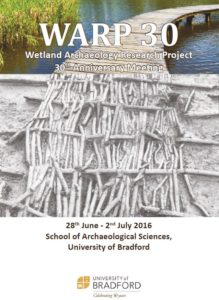WARP 30, Bradford 2016
In June 2016 Graeme Cavers and Anne Crone presented two papers on recent SWAP work on Iron Age wetland settlements in SW Scotland at the 30th Anniversary Meeting of the WARP conference. Read the abstracts below:
IRON AGE WETLAND LANDSCAPES: ADVANCES IN LAKE-SETTLEMENT STUDIES IN SCOTLAND
Graeme Cavers, Anne Crone
The Scottish Wetland Archaeology Programme (SWAP) formed at the WARP conference in Dublin in 1998, with the aim of better understanding the rich archaeological resource contained within Scotland’slochs, rivers, bogs and mires.
It is now ten years since a new research agenda was drafted for wetland archaeological studies in Scotland. In this time, there have been dramatic steps forward in our understanding of lake-settlements and their place in the settlement record of the Iron Age. Wetland archaeologists have long argued for an integrated, landscape-oriented approach to understanding the archaeology of wetlands, and this principle has been at the heart of research efforts by the SWAP programme in Galloway since 2007, particularly through the excavations of wetland and terrestrial settlements around Cults Loch, Castle Kennedy. Coupled with breakthroughs in prehistoric dendrochronology, multi-disciplinary research programmes and the (re)discovery of new and spectacular settlements, wetland studies in Scotland stand on the brink of a new era.
This paper will consider the progress made in the last decade, detailing the crannog excavations carried out in Galloway, reviewing the advances in our understanding and the implications for our models of later prehistoric society in Southern Scotland, before highlighting promising avenues for future research.
BLACK LOCH OF MYRTON; CHALLENGING PERCEPTIONS OF WETLAND SETTLEMENT IN SOUTH-WEST SCOTLAND
Anne Crone, Graeme Cavers
The work of the Scottish Wetland Archaeology Programme is revealing great variation in the types of wetland site used during the Iron Age in SW Scotland. Black Loch of Myrton had been labelled a crannog since its discovery in the 19th century but ongoing excavations have revealed that it was actually an Iron Age loch-village, the Scottish equivalent of the iconic Glastonbury Lake Village in Somerset. The settlement was built on a small peninsula of peat surrounded by a shallow, marshy loch and appears to consist of a cluster of roundhouses, which now survive as low mounds. So far, two roundhouses have been partially excavated and this has revealed that they had been built directly on the peat surface and that the mounds are massive stone-built central hearths. The degree of preservation in the houses is such that the posts still survive, as do the wattle screen sub-floors and the layers of rush and sedge flooring that was laid down, presumably as insulation.
Dendro-dating and wiggle-match dating have demonstrated that the houses were occupied for only a short period oftime in the middle of the 5th century BC, and analysis of artefact, macroplant and insect assemblages has revealed patterns of spatial organisation within the houses. This discovery has prompted many questions, not least of which is whether any or many of the other sites identified as crannogs in the 19th century were also loch-villages. Are these Iron Age villages translated into a wetland setting, an interim stage between the roundhouse settlements of the terrestrial record and the man-made island dwellings? As a hitherto undistinguished site-type, is the loch-village indicative of social and/or economic differences amongst the populace or simply evidence of the diversity of the people/place relationship in a densely occupied territory? In this presentation the evidence from Black Loch of Myrton will be interrogated to address these questions.

